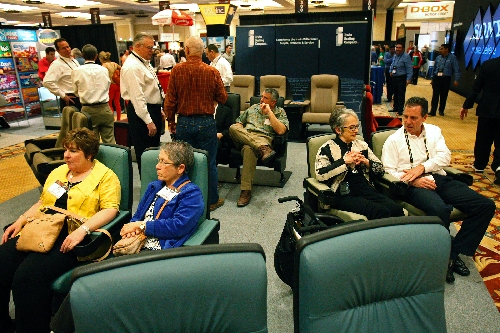Theater official optimistic despite attendance slump
Despite ticket sales that slumped 22 percent in the first two months of the year, John Fithian remains upbeat about the future for movie theater owners.
"Anyone want to name any movies this year that were great, that they rushed out to see?" asked Fithian, the president of the National Association of Theater Owners at the opening session of the group's CinemaCon convention at Caesars Palace.
The roster of movies in the pipeline for release this year gives him hope that attendance will rebound.
But what he portrayed as a short-term drought has extended for better than a decade. The 1.34 billion tickets sold in 2010 in the U.S. and Canada were the fewest in 15 years. The count has topped 1.5 billion only twice during that span.
"I don't think anybody really knows why the (attendance) numbers are flat," Martin Kaplan, director of the Norman Lear Center at the University of Southern California, a nonpartisan research center studying entertainment's social, political, economic and cultural impacts, wrote in an email. "It could be that the ticket price is too high, or that the content isn't sufficiently appealing to the most frequent moviegoers -- young men. Or (it could mean) even though there's nothing like the experience of watching in a theater, new technology means more screens and more types of content that movies have to compete against."
Financially, however, the picture has looked more appealing for theater owners. Since 1996, the box office gross has nearly doubled to $10.6 billion due to an almost-nonstop string of ticket-price increases. Although the association takes pains to point out that movies remain cheap compared with many other entertainment forms, average ticket prices have increased 40 percent over the past decade.
Fithian said the industry continues to follow a strategy of trying to wring more revenue from the base that it has, not only through boosting regular ticket prices but charging premiums for 3-D or IMAX productions, rather than by slashing prices to try to get more people in the door.
Last year, for example, sales for movies in 3-D doubled to $2.2 billion while sales for conventional 2-D movies dropped 11 percent to $8.4 billion.
After moving much more slowly than expected, installations of digital systems, which play movies off hard drives instead of a strips of celluloid, have quickly increased. Digital brings not only higher picture and sound quality, much like the difference between analog and high-definition TV, but makes theater operations more flexible.
However, the prospect of spending hundreds of thousands or millions of dollars to upgrade their equipment has unnerved theater owners.
"They want to know if they should invest in digital technologies or ride it out until the end of film prints and then do something else," Fithian said. "I tell them that the long-term future of exhibition looks quite good to me."
Former Sen. Christopher Dodd, D-Conn., the new head of the Motion Picture Association of America, predicted that films on film will disappear in less than three years.
Fithian's optimism is based on a rising birthrate in the U.S. plus a growing Hispanic population, which goes to movies more frequently than the rest of the population.
However, prices for big-screen televisions and home-theater kits continue to decline as 3-D TV performance improves.
CinemaCon, which attracted more than 6,000 delegates and exhibitors, is the successor to the ShoWest convention that was for years a staple of Las Vegas' convention calendar.
Contact reporter Tim O'Reiley at
toreiley@reviewjournal.com or 702-387-5290.


















